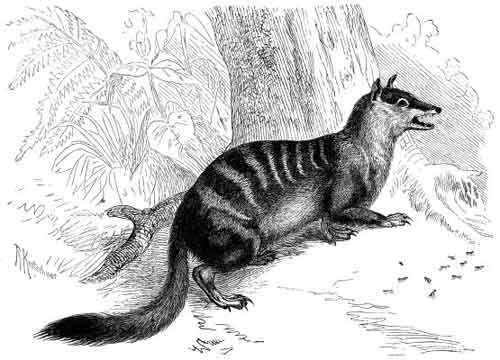|

Small, Colorful, Photogenic: It is a small, colorful, highly photogenic creature between 20 and a little under 30 cm long, with a finely pointed muzzle and a prominent, very bushy tail about the same length as the body.
 Coat of Many Colors: Color varies considerably, from soft gray to reddish-brown, often with an area of brick red on the upper back, and always with a conspicuous black stripe running from the tip of the muzzle through the eye to the base of the small, round-tipped ear. Coat of Many Colors: Color varies considerably, from soft gray to reddish-brown, often with an area of brick red on the upper back, and always with a conspicuous black stripe running from the tip of the muzzle through the eye to the base of the small, round-tipped ear.
The underside is cream or light gray; weight varies between 30 and just over 70 grams, the female usually being very slightly the larger of the two.

Termite Eaters: Unlike most other marsupials, the numbat is diurnal, largely because of the constraints of having a specialized diet without having the usual physical equipment for it. Most ecosystems with a generous supply of termites have a fairly large number of creatures with a very long, thin, sticky tongue for penetrating into termite colonies, and powerful forelimbs with heavy claws for breaking open the hardened, concrete-like surface of the nest.
Tongue for Termites: The numbat has the appropriate type of tongue and, as with other mammals that eat termites, a degenerate jaw with non-functional teeth, but it does not have especially strong forelimbs or particularly large claws, and is in any case too small to make much impression on a termite mound.
Unable to get at termites inside the mound, the numbat must wait until the termites are active: it uses a well-developed sense of smell to locate the shallow and unfortified underground galleries that termites construct between the nest and their feeding sites. These are usually only a short distance below the surface of the soil, and vulnerable to even the numbat's small claws.
 Daily Schedule: Numbats synchronize their day with termite activity, which is temperature dependent. Daily Schedule: Numbats synchronize their day with termite activity, which is temperature dependent.
Winter and Summer: In winter they feed from mid-morning to mid-afternoon; in summer they rise earlier, take shelter during the heat of the day, and feed again in the late afternoon.
Numbat Homes: At night, numbats retreat to a nest, which can be in a hollow log or tree, or in a burrow, typically a narrow shaft one or two meters long, which terminates in a spherical chamber, lined with soft plant material: grass, leaves, flowers, and shredded bark.
Adult numbats are solitary and territorial; an individual of either sex establishes a territory early in life, defends it from others of the same sex, and generally remains within it from that time on; male and female territories overlap, and in the breeding season males will venture outside their normal home range to find mates.

Birds and Bees: Breeding takes place in high summer, all females coming into estrus for a short period in January. Gestation takes about 14 days and four young are usually born, one for each teat. They remain in the pouch until July, at which time the female leaves them in the burrow, returning to suckle them from time to time.
They Grow Up So Fast: By early September, the young begin to emerge from the nest for short periods each day, staying very close to the entrance when the mother departs, and playing together or basking in the spring sunshine for an hour or two before returning. Gradually, they venture further from the burrow: they are weaned by late October, sleeping away from the mother by late October, and in December they set off to establish a territory of their own.

Vulnerable Species: Until European colonization, numbats were found across most of the area from the New South Wales and Victorian borders west to the Indian ocean, and as far north as the south-west corner of the Northern Territory. It was at home in a wide range of woodland and semi-arid habitats. The deliberate release of the European Red Fox in the 19th century, however, wiped out the entire numbat populations in Victoria, NSW, South Australia, and the Northern Territory, and almost in Western Australia as well. By the late 1970s, the entire population was well under 1000 individuals, concentrated in two small areas not far from Perth, Dryandra and Perup.

Foxes are the Enemy: It appears that the reason these two small populations were able to survive is that both areas have many hollow logs to serve as refuges from predators. Being diurnal, the numbat is much more vulnerable to predation than most other marsupials of a similar size: its natural predators include the Little Eagle, Brown Goshawk, Collared Sparrowhawk and Carpet Python but, apparently, no land-based mammals. When the Western Australian government instituted an experimental program of fox baiting at Dryandra (one of the two remaining sites), numbat sightings increased by a factor of 40.
On The Rebound: An intensive research and conservation program since 1980 has succeeded in increasing the numbat population substantially, and reintroductions to fox-free areas have begun. Despite the encouraging degree of success so far, the numbat remains at considerable risk of extinction and although no longer on the seriously endangered list is still classified as vulnerable.

All text is available under the terms
of the GNU Free Documentation License
|